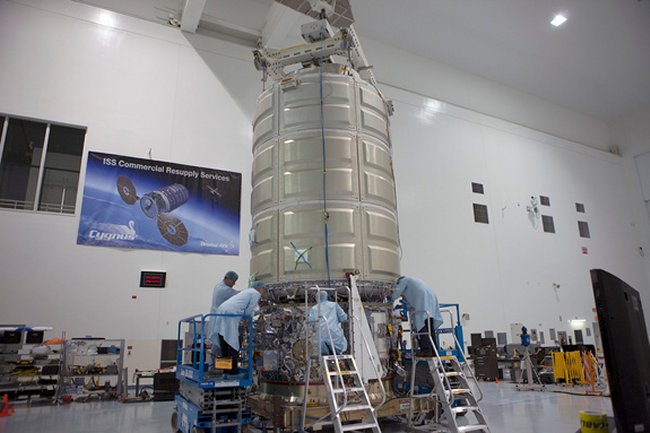Cygnus Cargo Ship Makes Return-to-Flight Launch for NASA Today: Watch It Live
MessageToEagle.com – Orbital ATK’s unmanned Cygnus spacecraft is set to embark upon its return-to-flight mission tonight (Dec. 3), carrying more than 7,700 lbs. (3500 kilograms) of research materials, crew supplies and hardware for the International Space Station — and you can watch the lift off live.
The Cygnus is scheduled to launch at 5:55 p.m. EST (2255 GMT) from Cape Canaveral Air Force Station in Florida aboard a United Launch Alliance Atlas V rocket, in the first liftoff for the freighter since Orbital’s Antares rocket explodedduring a cargo delivery last October. (Cygus will fly atop an Atlas V until a revamped version of Antares is ready to go.) The launch will initiate the fourth of eight resupply missions Orbital ATK is flying under a $1.9 billion contract with NASA. The live webcast of the OA-4 mission will begin at 4:30 p.m. EST (2130 GMT).
You can watch it here at Space.com, courtesy of NASA TV.
As of this morning, there’s a 60 percent chance that weather conditions will be favorable for the launch, U.S. Air Force officials reported. If the launch occurs on schedule, the spacecraft will reach the space station Sunday, Dec. 6, where NASA astronaut Kjell Lindgren will take point on capturing it via the station’s Canadarm2 robotic arm, assisted by NASA astronaut Scott Kelly. If weather conditions worsen, the team will attempt to launch again tomorrow (Dec. 4) for a Dec. 7 or Dec. 8 arrival.
“We feel extremely confident, or we wouldn’t be sitting on top of that rocket,” Frank Culbertson, Space Systems Group president at Orbital ATK, said in a press briefing Wednesday (Dec. 2).

Credit: NASA
“We’re dealing with a lot of energy, a lot of power coming off the pad, and a lot of complexity in the vehicles, and that’s just a part of the business,” Culbertson added. “And we’ve learned that the hard way over the years many times. But we always come back from that, and we always do whatever’s necessary to correct whatever problems occur, whether minor or major.”
Cygnus’ previous launch was the first of three cargo delivery failures over the past year, and will be the first to return to flight. The other two freighters that had problems over the last 12 months — SpaceX’s Dragon capsule and Russia’s Progress spacecraft — could launch again within 31 days of Cygnus, Kirk Shireman, the International Space Station’s program manager, said during the briefing.
More than a third of that capacity will be given over to science experiments, Culbertson said. The rest will be food and other crew supplies, plus replacement hardware for the International Space Station whose delivery has been delayed.Orbital ATK plans to send this Cygnus spacecraft and the next one, in March, to orbit aboard Atlas V rockets before deploying an updated version of Orbital’s Antares rocket. The Antares explosion upon launch was likely caused by a problem with one of its first-stage AJ26 engines, and the new Antares will be updated to run with a Russian-made RD-180 engine (which is also used for the Atlas V’s first stage). To bring more cargo up at once, this and future launches will send up an enhanced Cygnus with additional storage capacity compared to its previous forays, Orbital representatives said.
A life science research module, around the size of a locker, will ride aboard Cygnus. Once it reaches the space station, the facility will be able to incubate organisms such as bacteria, yeast, algae, fungi and animal cells for study in space’s unique conditions. Another experiment will test the behavior of flame-resistant and flame-retardant textiles in microgravity. And another experiment will study how gases and liquids moving through porous material — research that is relevant to water reclamation, removing carbon dioxide from the air and many other essential space station tasks.

Credit: Orbital ATK
In addition, several student experiments will fly aboard Orbital ATK’s OA-4 mission, including some that were initially intended for earlier, failed missions. Ken Shields, director of Operations and Education Research at the Center for the Advancement of Science in Space (CASIS), emphasized the value of that learning experience and the students’ excitement that the experiments would still get to fly.
“OA-4 represents the return-to-flight of our commercial resupply missions,” Shields said at a science press briefing Wednesday. “It also signifies and represents the return-to-flight of no less than five STEM [science, technology, engineering and math] experiments that were lost on those launch anomalies.”
MessageToEagle.com via Space.com
This article was originally published on Space.com – the leading space news site on the web keeping up on the latest space science, technology and astronomy news.










